Tong Zhao
Exploring Landscapes for Better Minima along Valleys
Oct 31, 2025Abstract:Finding lower and better-generalizing minima is crucial for deep learning. However, most existing optimizers stop searching the parameter space once they reach a local minimum. Given the complex geometric properties of the loss landscape, it is difficult to guarantee that such a point is the lowest or provides the best generalization. To address this, we propose an adaptor "E" for gradient-based optimizers. The adapted optimizer tends to continue exploring along landscape valleys (areas with low and nearly identical losses) in order to search for potentially better local minima even after reaching a local minimum. This approach increases the likelihood of finding a lower and flatter local minimum, which is often associated with better generalization. We also provide a proof of convergence for the adapted optimizers in both convex and non-convex scenarios for completeness. Finally, we demonstrate their effectiveness in an important but notoriously difficult training scenario, large-batch training, where Lamb is the benchmark optimizer. Our testing results show that the adapted Lamb, ALTO, increases the test accuracy (generalization) of the current state-of-the-art optimizer by an average of 2.5% across a variety of large-batch training tasks. This work potentially opens a new research direction in the design of optimization algorithms.
WorldForge: Unlocking Emergent 3D/4D Generation in Video Diffusion Model via Training-Free Guidance
Sep 18, 2025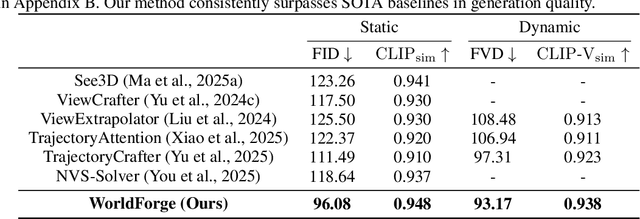
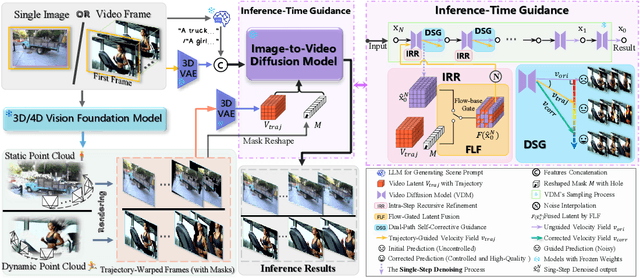
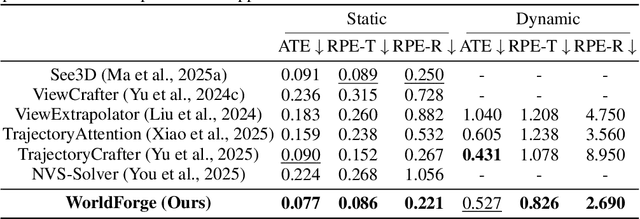
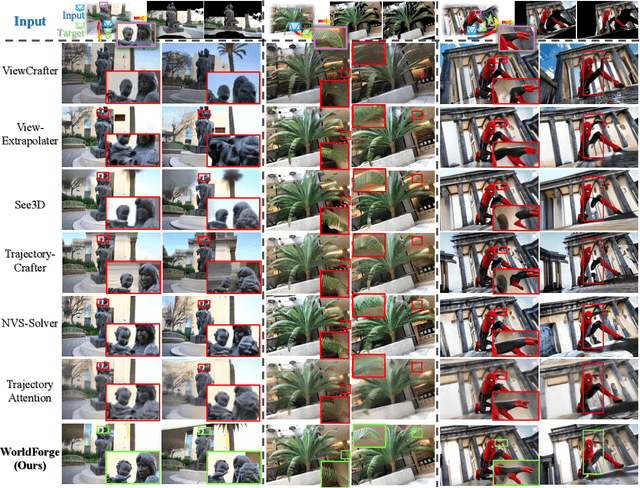
Abstract:Recent video diffusion models demonstrate strong potential in spatial intelligence tasks due to their rich latent world priors. However, this potential is hindered by their limited controllability and geometric inconsistency, creating a gap between their strong priors and their practical use in 3D/4D tasks. As a result, current approaches often rely on retraining or fine-tuning, which risks degrading pretrained knowledge and incurs high computational costs. To address this, we propose WorldForge, a training-free, inference-time framework composed of three tightly coupled modules. Intra-Step Recursive Refinement introduces a recursive refinement mechanism during inference, which repeatedly optimizes network predictions within each denoising step to enable precise trajectory injection. Flow-Gated Latent Fusion leverages optical flow similarity to decouple motion from appearance in the latent space and selectively inject trajectory guidance into motion-related channels. Dual-Path Self-Corrective Guidance compares guided and unguided denoising paths to adaptively correct trajectory drift caused by noisy or misaligned structural signals. Together, these components inject fine-grained, trajectory-aligned guidance without training, achieving both accurate motion control and photorealistic content generation. Extensive experiments across diverse benchmarks validate our method's superiority in realism, trajectory consistency, and visual fidelity. This work introduces a novel plug-and-play paradigm for controllable video synthesis, offering a new perspective on leveraging generative priors for spatial intelligence.
Generative Recommendation with Semantic IDs: A Practitioner's Handbook
Jul 29, 2025Abstract:Generative recommendation (GR) has gained increasing attention for its promising performance compared to traditional models. A key factor contributing to the success of GR is the semantic ID (SID), which converts continuous semantic representations (e.g., from large language models) into discrete ID sequences. This enables GR models with SIDs to both incorporate semantic information and learn collaborative filtering signals, while retaining the benefits of discrete decoding. However, varied modeling techniques, hyper-parameters, and experimental setups in existing literature make direct comparisons between GR proposals challenging. Furthermore, the absence of an open-source, unified framework hinders systematic benchmarking and extension, slowing model iteration. To address this challenge, our work introduces and open-sources a framework for Generative Recommendation with semantic ID, namely GRID, specifically designed for modularity to facilitate easy component swapping and accelerate idea iteration. Using GRID, we systematically experiment with and ablate different components of GR models with SIDs on public benchmarks. Our comprehensive experiments with GRID reveal that many overlooked architectural components in GR models with SIDs substantially impact performance. This offers both novel insights and validates the utility of an open-source platform for robust benchmarking and GR research advancement. GRID is open-sourced at https://github.com/snap-research/GRID.
Adapting Vision-Language Foundation Model for Next Generation Medical Ultrasound Image Analysis
Jun 11, 2025Abstract:Medical ultrasonography is an essential imaging technique for examining superficial organs and tissues, including lymph nodes, breast, and thyroid. It employs high-frequency ultrasound waves to generate detailed images of the internal structures of the human body. However, manually contouring regions of interest in these images is a labor-intensive task that demands expertise and often results in inconsistent interpretations among individuals. Vision-language foundation models, which have excelled in various computer vision applications, present new opportunities for enhancing ultrasound image analysis. Yet, their performance is hindered by the significant differences between natural and medical imaging domains. This research seeks to overcome these challenges by developing domain adaptation methods for vision-language foundation models. In this study, we explore the fine-tuning pipeline for vision-language foundation models by utilizing large language model as text refiner with special-designed adaptation strategies and task-driven heads. Our approach has been extensively evaluated on six ultrasound datasets and two tasks: segmentation and classification. The experimental results show that our method can effectively improve the performance of vision-language foundation models for ultrasound image analysis, and outperform the existing state-of-the-art vision-language and pure foundation models. The source code of this study is available at https://github.com/jinggqu/NextGen-UIA.
Learning Along the Arrow of Time: Hyperbolic Geometry for Backward-Compatible Representation Learning
Jun 06, 2025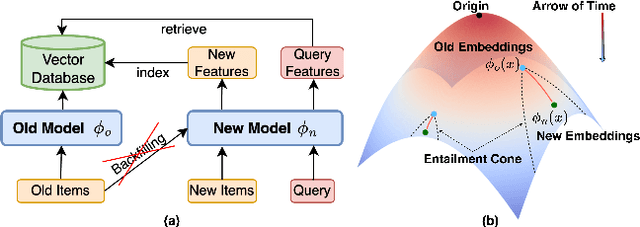
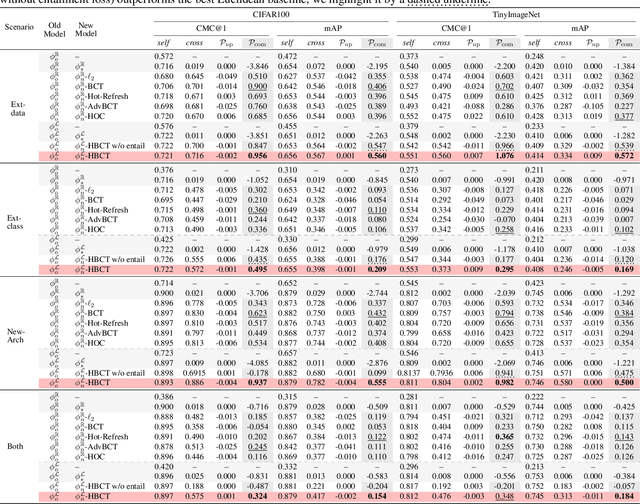
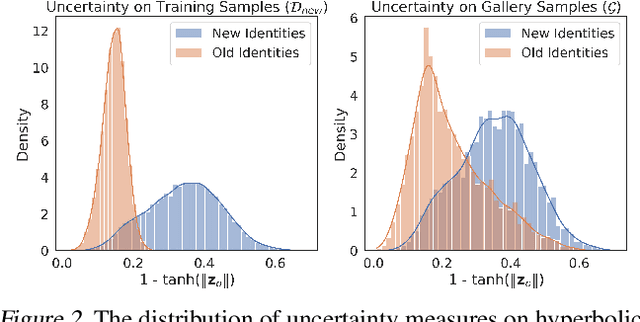
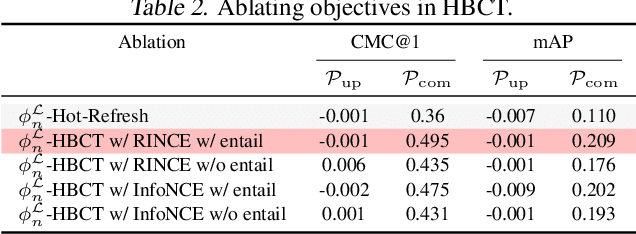
Abstract:Backward compatible representation learning enables updated models to integrate seamlessly with existing ones, avoiding to reprocess stored data. Despite recent advances, existing compatibility approaches in Euclidean space neglect the uncertainty in the old embedding model and force the new model to reconstruct outdated representations regardless of their quality, thereby hindering the learning process of the new model. In this paper, we propose to switch perspectives to hyperbolic geometry, where we treat time as a natural axis for capturing a model's confidence and evolution. By lifting embeddings into hyperbolic space and constraining updated embeddings to lie within the entailment cone of the old ones, we maintain generational consistency across models while accounting for uncertainties in the representations. To further enhance compatibility, we introduce a robust contrastive alignment loss that dynamically adjusts alignment weights based on the uncertainty of the old embeddings. Experiments validate the superiority of the proposed method in achieving compatibility, paving the way for more resilient and adaptable machine learning systems.
Revisiting Self-attention for Cross-domain Sequential Recommendation
May 27, 2025Abstract:Sequential recommendation is a popular paradigm in modern recommender systems. In particular, one challenging problem in this space is cross-domain sequential recommendation (CDSR), which aims to predict future behaviors given user interactions across multiple domains. Existing CDSR frameworks are mostly built on the self-attention transformer and seek to improve by explicitly injecting additional domain-specific components (e.g. domain-aware module blocks). While these additional components help, we argue they overlook the core self-attention module already present in the transformer, a naturally powerful tool to learn correlations among behaviors. In this work, we aim to improve the CDSR performance for simple models from a novel perspective of enhancing the self-attention. Specifically, we introduce a Pareto-optimal self-attention and formulate the cross-domain learning as a multi-objective problem, where we optimize the recommendation task while dynamically minimizing the cross-domain attention scores. Our approach automates knowledge transfer in CDSR (dubbed as AutoCDSR) -- it not only mitigates negative transfer but also encourages complementary knowledge exchange among auxiliary domains. Based on the idea, we further introduce AutoCDSR+, a more performant variant with slight additional cost. Our proposal is easy to implement and works as a plug-and-play module that can be incorporated into existing transformer-based recommenders. Besides flexibility, it is practical to deploy because it brings little extra computational overheads without heavy hyper-parameter tuning. AutoCDSR on average improves Recall@10 for SASRec and Bert4Rec by 9.8% and 16.0% and NDCG@10 by 12.0% and 16.7%, respectively. Code is available at https://github.com/snap-research/AutoCDSR.
On the Role of Weight Decay in Collaborative Filtering: A Popularity Perspective
May 16, 2025Abstract:Collaborative filtering (CF) enables large-scale recommendation systems by encoding information from historical user-item interactions into dense ID-embedding tables. However, as embedding tables grow, closed-form solutions become impractical, often necessitating the use of mini-batch gradient descent for training. Despite extensive work on designing loss functions to train CF models, we argue that one core component of these pipelines is heavily overlooked: weight decay. Attaining high-performing models typically requires careful tuning of weight decay, regardless of loss, yet its necessity is not well understood. In this work, we question why weight decay is crucial in CF pipelines and how it impacts training. Through theoretical and empirical analysis, we surprisingly uncover that weight decay's primary function is to encode popularity information into the magnitudes of the embedding vectors. Moreover, we find that tuning weight decay acts as a coarse, non-linear knob to influence preference towards popular or unpopular items. Based on these findings, we propose PRISM (Popularity-awaRe Initialization Strategy for embedding Magnitudes), a straightforward yet effective solution to simplify the training of high-performing CF models. PRISM pre-encodes the popularity information typically learned through weight decay, eliminating its necessity. Our experiments show that PRISM improves performance by up to 4.77% and reduces training times by 38.48%, compared to state-of-the-art training strategies. Additionally, we parameterize PRISM to modulate the initialization strength, offering a cost-effective and meaningful strategy to mitigate popularity bias.
Dexterous Contact-Rich Manipulation via the Contact Trust Region
May 04, 2025Abstract:What is a good local description of contact dynamics for contact-rich manipulation, and where can we trust this local description? While many approaches often rely on the Taylor approximation of dynamics with an ellipsoidal trust region, we argue that such approaches are fundamentally inconsistent with the unilateral nature of contact. As a remedy, we present the Contact Trust Region (CTR), which captures the unilateral nature of contact while remaining efficient for computation. With CTR, we first develop a Model-Predictive Control (MPC) algorithm capable of synthesizing local contact-rich plans. Then, we extend this capability to plan globally by stitching together local MPC plans, enabling efficient and dexterous contact-rich manipulation. To verify the performance of our method, we perform comprehensive evaluations, both in high-fidelity simulation and on hardware, on two contact-rich systems: a planar IiwaBimanual system and a 3D AllegroHand system. On both systems, our method offers a significantly lower-compute alternative to existing RL-based approaches to contact-rich manipulation. In particular, our Allegro in-hand manipulation policy, in the form of a roadmap, takes fewer than 10 minutes to build offline on a standard laptop using just its CPU, with online inference taking just a few seconds. Experiment data, video and code are available at ctr.theaiinstitute.com.
Learning Universal User Representations Leveraging Cross-domain User Intent at Snapchat
Apr 30, 2025Abstract:The development of powerful user representations is a key factor in the success of recommender systems (RecSys). Online platforms employ a range of RecSys techniques to personalize user experience across diverse in-app surfaces. User representations are often learned individually through user's historical interactions within each surface and user representations across different surfaces can be shared post-hoc as auxiliary features or additional retrieval sources. While effective, such schemes cannot directly encode collaborative filtering signals across different surfaces, hindering its capacity to discover complex relationships between user behaviors and preferences across the whole platform. To bridge this gap at Snapchat, we seek to conduct universal user modeling (UUM) across different in-app surfaces, learning general-purpose user representations which encode behaviors across surfaces. Instead of replacing domain-specific representations, UUM representations capture cross-domain trends, enriching existing representations with complementary information. This work discusses our efforts in developing initial UUM versions, practical challenges, technical choices and modeling and research directions with promising offline performance. Following successful A/B testing, UUM representations have been launched in production, powering multiple use cases and demonstrating their value. UUM embedding has been incorporated into (i) Long-form Video embedding-based retrieval, leading to 2.78% increase in Long-form Video Open Rate, (ii) Long-form Video L2 ranking, with 19.2% increase in Long-form Video View Time sum, (iii) Lens L2 ranking, leading to 1.76% increase in Lens play time, and (iv) Notification L2 ranking, with 0.87% increase in Notification Open Rate.
BEV-GS: Feed-forward Gaussian Splatting in Bird's-Eye-View for Road Reconstruction
Apr 16, 2025Abstract:Road surface is the sole contact medium for wheels or robot feet. Reconstructing road surface is crucial for unmanned vehicles and mobile robots. Recent studies on Neural Radiance Fields (NeRF) and Gaussian Splatting (GS) have achieved remarkable results in scene reconstruction. However, they typically rely on multi-view image inputs and require prolonged optimization times. In this paper, we propose BEV-GS, a real-time single-frame road surface reconstruction method based on feed-forward Gaussian splatting. BEV-GS consists of a prediction module and a rendering module. The prediction module introduces separate geometry and texture networks following Bird's-Eye-View paradigm. Geometric and texture parameters are directly estimated from a single frame, avoiding per-scene optimization. In the rendering module, we utilize grid Gaussian for road surface representation and novel view synthesis, which better aligns with road surface characteristics. Our method achieves state-of-the-art performance on the real-world dataset RSRD. The road elevation error reduces to 1.73 cm, and the PSNR of novel view synthesis reaches 28.36 dB. The prediction and rendering FPS is 26, and 2061, respectively, enabling high-accuracy and real-time applications. The code will be available at: \href{https://github.com/cat-wwh/BEV-GS}{\texttt{https://github.com/cat-wwh/BEV-GS}}
 Add to Chrome
Add to Chrome Add to Firefox
Add to Firefox Add to Edge
Add to Edge